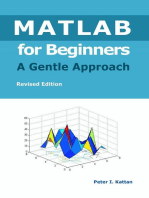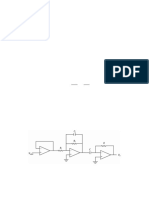LabInstr EE370L Lab2
Uploaded by
Mohammad alhaboob2030LabInstr EE370L Lab2
Uploaded by
Mohammad alhaboob2030EE 370 L CONTROL SYSTEM LABORATORY
LABORATORY 2: TRANSFER FUNCTION SIMPLIFICATION AND SOLUTION
DEPARTMENT OF ELECTRICAL AND COMPUTER ENGINEERING
UNIVERSITY OF NEVADA, LAS VEGAS
1. OBJECTIVE
In this laboratory exercise, you will practice block diagram reduction and simulating response
for various inputs for a transfer function using MATLAB.
2. COMPONENTS & EQUIPMENT
PC with MATLAB and Simulink toolbox installed.
3. BACKGROUND
In engineering, a transfer function (also known as system function or network function) of an
electronic or control system component is a mathematical function which theoretically models the
device's output for each possible input.
The term "transfer function" is also used in the frequency domain analysis of systems using
transform methods such as the Laplace transform; here it means the amplitude of the output as a
function of the frequency of the input signal. For example, the transfer function of an electronic
filter is the voltage amplitude at the output as a function of the frequency of a constant amplitude
sine wave applied to the input. For optical imaging devices, the optical transfer function is the
Fourier transform of the point spread function (hence a function of spatial frequency).
DEPARTMENT OF ELECTRICAL AND COMPUTER ENGINEERING 1
EE 370L CONTROL SYSTEM LABORATORY
Example 1: Check responses of the following system when k = 1, 2, 2.25, 3, respectively.
Figure 2.1 System 1
Close-loop transfer function:
𝑘
𝑠2+𝑠−2 = 𝑘
𝐺(𝑠) =
𝑘 2
𝑠 + 𝑠 + (𝑘 − 2)
1+ 2
𝑠 +𝑠−2
MATLAB code example: Results:
k = 5;
num = [k];
den = [1, 1, k-2];
sys = tf(num, den);
z = zero(sys)
p = pole(sys)
r = roots(den)
figure(1), step(sys)
figure(2), impulse(sys)
System Response:
DEPARTMENT OF ELECTRICAL AND COMPUTER ENGINEERING 2
EE 370L CONTROL SYSTEM LABORATORY
Example 2. Check the system responses when [a,b] = [0,1], [1,0], [0,0].
Figure 2.2 System 2
Transfer function:
1
𝐺(𝑠) = 𝑠+𝑎
1 𝑏2
1+( )×(
𝑠+𝑎 𝑠 + 𝑎)
MATLAB code example: Results:
a=1; b=1;
num=[1,a];
den=[1,2*a,a^2+b^2];
sys=tf(num,den);
z=zero(sys)
p=pole(sys)
r=roots(den)
figure(1), step(sys)
figure(2),impulse(sys)
System Response:
DEPARTMENT OF ELECTRICAL AND COMPUTER ENGINEERING 3
EE 370L CONTROL SYSTEM LABORATORY
4. LAB DELIVERIES
PRELAB:
1. Review the knowledge of Laplace Transforms and transfer function.
https://en.wikipedia.org/wiki/Laplace_transform#Properties_and_theorems
2. Learn, exercise and understand the MATLAB code examples for the two system in Figure 2.1
and Figure 2.2.
3. Derive the transfer functions for the System 3 and System 4 as follows, respectively.
+ + Y(s)
+ s+4 + +
– –
0.5s
Figure 3. System 3
Figure 4. System 4
DEPARTMENT OF ELECTRICAL AND COMPUTER ENGINEERING 4
EE 370L CONTROL SYSTEM LABORATORY
LAB EXPERIMENTS:
1. Plot step and impulse response of System 3.
• Use both MATLAB coding to plot the responses with derived transfer function
• Use Simulink block diagram to run the simulations
• Compare the results
2. Use MATLAB to plot step and impulse response of System 4 with derived transfer function:
1) if [a, b, c, d] = [0, 1, 1, 1];
2) if [a, b, c, d] = [1, 1, 0, 0].
3) if [a, b, c, d] = [1, 1, 1, 1].
4) Compare and explain why these results of the 3 sets of variables are different?
5) Repeat Step 1) ~ 3) with Simulink block diagram, and compare the results.
POSTLAB REPORT:
Include the following elements in the report document:
Section Element
Theory of operation
1
Include a brief description of every element and phenomenon that appear during the experiments.
Prelab report
2 1. Hand calculation results of prelab for System 3 & 4.
2. (Optional) LTspice schematics and simulation results of System 3 & 4.
Results of the experiments
Experiments Experiment Results
3
1 MATLAB code and simulation results Experiment 1.
2 MATLAB code and simulation results Experiment 2.
Answer the questions
4 Questions Questions
1 Question in Experiment 2.
Conclusions
5 Write down your conclusions, things learned, problems encountered during the lab and how they were
solved, etc.
Images
Paste images (e.g. scratches, drafts, screenshots, photos, etc.) in Postlab report document (only .docx,
.doc or .pdf format is accepted). If the sizes of images are too large, convert them to jpg/jpeg format
first, and then paste them in the document.
6
Attachments (If needed)
Zip your projects. Send through WebCampus as attachments, or provide link to the zip file on Google
Drive / Dropbox, etc.
DEPARTMENT OF ELECTRICAL AND COMPUTER ENGINEERING 5
EE 370L CONTROL SYSTEM LABORATORY
5. REFERENCES & ACKNOWLEDGEMENT
1. Norman S. Nise, “Control Systems Engineering”, 7th Ed.
2. https://en.wikipedia.org/wiki/Transfer_function
I appreciate the help from faculty members and TAs during the composing of this instruction
manual. I would also thank students who provide valuable feedback so that we can offer better
higher education to the students.
DEPARTMENT OF ELECTRICAL AND COMPUTER ENGINEERING 6
You might also like
- Introduction To Control System Technology, 7ed100% (2)Introduction To Control System Technology, 7ed710 pages
- MCE 4603 Lab 4 - Open and Closed Loop SystemNo ratings yetMCE 4603 Lab 4 - Open and Closed Loop System6 pages
- Lab 1 Transfer Function and System ResponseNo ratings yetLab 1 Transfer Function and System Response10 pages
- EEF460 - Feedback Systems Laboratory OutlineNo ratings yetEEF460 - Feedback Systems Laboratory Outline5 pages
- ECE131L Experiment 2: System Generation, Retrieval, and InterconnectionNo ratings yetECE131L Experiment 2: System Generation, Retrieval, and Interconnection2 pages
- Lab 4: Linear Time-Invariant Systems and Representation: ObjectivesNo ratings yetLab 4: Linear Time-Invariant Systems and Representation: Objectives6 pages
- Ransfer Unction Epresentation: ObjectivesNo ratings yetRansfer Unction Epresentation: Objectives14 pages
- EEF460_Feedback Systems Laboratory Outline 2025No ratings yetEEF460_Feedback Systems Laboratory Outline 20256 pages
- Edrada, Judy Ann N. - ME416A - EXPERIMENT 2 - LateNo ratings yetEdrada, Judy Ann N. - ME416A - EXPERIMENT 2 - Late5 pages
- Experiment No: 1: Aim: Software Used TheoryNo ratings yetExperiment No: 1: Aim: Software Used Theory12 pages
- Experiment No.1 - Introduction To MATLAB and Simulink Software ToolsNo ratings yetExperiment No.1 - Introduction To MATLAB and Simulink Software Tools2 pages
- EE-361 Feedback Control Systems Basic MATLAB Commands Experiment # 1No ratings yetEE-361 Feedback Control Systems Basic MATLAB Commands Experiment # 18 pages
- Experiment No. 01 Introduction To System Representation and Observation Using MATLABNo ratings yetExperiment No. 01 Introduction To System Representation and Observation Using MATLAB20 pages
- Louise Lope Adonis Pabillaran - Activity 3No ratings yetLouise Lope Adonis Pabillaran - Activity 311 pages
- Laboratory Manual: College of Engineering, OsmanabadNo ratings yetLaboratory Manual: College of Engineering, Osmanabad70 pages
- MATLAB For Engineering Applications 4th Ed 2019 Ebook Chap 1 SolNo ratings yetMATLAB For Engineering Applications 4th Ed 2019 Ebook Chap 1 Sol56 pages
- Lab Manual Control Lab To Determine The Response of Ist Order and Iind OrderNo ratings yetLab Manual Control Lab To Determine The Response of Ist Order and Iind Order9 pages
- 2001 Frequency-Domain Analysis of Three-Phase Linear Current Regulators PDFNo ratings yet2001 Frequency-Domain Analysis of Three-Phase Linear Current Regulators PDF10 pages
- Chapter 3 Mathematical Modeling of Dynamic SystemsNo ratings yetChapter 3 Mathematical Modeling of Dynamic Systems28 pages
- Control Systems Lab #3: Stability AnalysisNo ratings yetControl Systems Lab #3: Stability Analysis5 pages
- Matlab and Simulink For Modeling and Control DC MotorNo ratings yetMatlab and Simulink For Modeling and Control DC Motor14 pages
- Control Systems Mathematical Modelling of Mechanical SystemsNo ratings yetControl Systems Mathematical Modelling of Mechanical Systems14 pages
- Feedback Control Systems (FCS) : Lecture-18 Steady State ErrorNo ratings yetFeedback Control Systems (FCS) : Lecture-18 Steady State Error23 pages
- Lab 7 - Frequency Response Computations: AgendaNo ratings yetLab 7 - Frequency Response Computations: Agenda8 pages
- Chapter-4-Discrete Time Signal in Transform DomainNo ratings yetChapter-4-Discrete Time Signal in Transform Domain26 pages
- Algebra Block Diagram - Control Systems Questions and AnswersNo ratings yetAlgebra Block Diagram - Control Systems Questions and Answers5 pages
- Phaselock Techniques 3rd Edition Floyd M. Gardner All Chapters Instant Download100% (3)Phaselock Techniques 3rd Edition Floyd M. Gardner All Chapters Instant Download67 pages
- Linear System Theory: 2.1 Discrete-Time SignalsNo ratings yetLinear System Theory: 2.1 Discrete-Time Signals31 pages
- Modelling of Soil-Structure Interaction in OpenSeesNo ratings yetModelling of Soil-Structure Interaction in OpenSees14 pages
- The Z Transform, System Transfer Function, Poles and StabilityNo ratings yetThe Z Transform, System Transfer Function, Poles and Stability18 pages
- CHE3007s - Process Control - Lecture 15 - ReviewNo ratings yetCHE3007s - Process Control - Lecture 15 - Review15 pages
- 1.0 Automatic Generation Control: Compiled by Shima100% (1)1.0 Automatic Generation Control: Compiled by Shima41 pages
- ECE131L Experiment 2: System Generation, Retrieval, and InterconnectionECE131L Experiment 2: System Generation, Retrieval, and Interconnection
- Lab 4: Linear Time-Invariant Systems and Representation: ObjectivesLab 4: Linear Time-Invariant Systems and Representation: Objectives
- Edrada, Judy Ann N. - ME416A - EXPERIMENT 2 - LateEdrada, Judy Ann N. - ME416A - EXPERIMENT 2 - Late
- Experiment No.1 - Introduction To MATLAB and Simulink Software ToolsExperiment No.1 - Introduction To MATLAB and Simulink Software Tools
- EE-361 Feedback Control Systems Basic MATLAB Commands Experiment # 1EE-361 Feedback Control Systems Basic MATLAB Commands Experiment # 1
- Experiment No. 01 Introduction To System Representation and Observation Using MATLABExperiment No. 01 Introduction To System Representation and Observation Using MATLAB
- MATLAB for Beginners: A Gentle Approach - Revised EditionFrom EverandMATLAB for Beginners: A Gentle Approach - Revised Edition
- Laboratory Manual: College of Engineering, OsmanabadLaboratory Manual: College of Engineering, Osmanabad
- MATLAB For Engineering Applications 4th Ed 2019 Ebook Chap 1 SolMATLAB For Engineering Applications 4th Ed 2019 Ebook Chap 1 Sol
- Lab Manual Control Lab To Determine The Response of Ist Order and Iind OrderLab Manual Control Lab To Determine The Response of Ist Order and Iind Order
- 2001 Frequency-Domain Analysis of Three-Phase Linear Current Regulators PDF2001 Frequency-Domain Analysis of Three-Phase Linear Current Regulators PDF
- Chapter 3 Mathematical Modeling of Dynamic SystemsChapter 3 Mathematical Modeling of Dynamic Systems
- Matlab and Simulink For Modeling and Control DC MotorMatlab and Simulink For Modeling and Control DC Motor
- Control Systems Mathematical Modelling of Mechanical SystemsControl Systems Mathematical Modelling of Mechanical Systems
- Feedback Control Systems (FCS) : Lecture-18 Steady State ErrorFeedback Control Systems (FCS) : Lecture-18 Steady State Error
- Chapter-4-Discrete Time Signal in Transform DomainChapter-4-Discrete Time Signal in Transform Domain
- Algebra Block Diagram - Control Systems Questions and AnswersAlgebra Block Diagram - Control Systems Questions and Answers
- Phaselock Techniques 3rd Edition Floyd M. Gardner All Chapters Instant DownloadPhaselock Techniques 3rd Edition Floyd M. Gardner All Chapters Instant Download
- Modelling of Soil-Structure Interaction in OpenSeesModelling of Soil-Structure Interaction in OpenSees
- The Z Transform, System Transfer Function, Poles and StabilityThe Z Transform, System Transfer Function, Poles and Stability
- 1.0 Automatic Generation Control: Compiled by Shima1.0 Automatic Generation Control: Compiled by Shima









































































































